The immature or larval stages of insects, particularly beetles and moths, that feed on wood rather than leaves or plant juices are referred to as borers. All the woody parts of the tree from the buds and twigs to the trunk and roots are susceptible to borer attack. Most borers are attracted to trees that are weakened through drought, injury or disease, but some borer species can successfully attack healthy, vigorous trees.
Once borers have infested a tree, they can be difficult to control. Insecticidal sprays can be successful only if they are applied to the tree when the adult borers are active and laying eggs. Consequently, the proper timing of insecticide sprays is crucial for effective chemical control of borers.
This guide describes the biology and control of some of the more commonly occurring insect borers known to attack fruit and many species of shade trees in Missouri.
Flatheaded appletree borer
Chrysobothris femorata (Olivier) — Coleoptera: Buprestidae
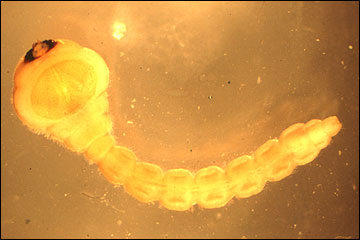 Figure 1
Figure 1
Larva of a flatheaded appletree borer.
Hosts
The flatheaded appletree borer is a very common borer that occurs throughout the United States and most of Canada. It attacks fruit trees, such as apple and pear, and a wide variety of shade and forest trees, such as oak, maple, poplar, elm, sycamore, walnut and hickory.
Damage
The bark over infested areas often is dead and dark-colored. Young trees can be girdled and killed, and larger trees can be seriously injured through the loss of large portions of bark. This borer can be very destructive to newly planted trees and trees stressed by drought or other factors.
Biology
The adult beetle is about 0.5 inch long, oval and flattened, and can have a metallic green-copper color. The body is very blunt at the head and tapers to a rounded point at the posterior end.
Adults typically begin emerging in May and egg-laying can continue from June to September. Hence, larvae of varying sizes may be found throughout the summer. Adults are sun-loving insects and can be found in greatest numbers on the sunny sides of trees or logs. Eggs typically are deposited under bark scales or in bark crevices on the south and west sides of the main trunk and larger branches.
The larvae bore, or tunnel, into the bark and feed on the phloem and outer sapwood. Tunnels in trees often can be 3 inches long or more. As the larva feeds, it fills the tunnel with a powdery frass. Mature larvae are white, about 1 inch long, and slender, except for a broad, flat enlargement of the thoracic segments behind the head (Figure 1). During the fall the larva will bore deeper into the wood, where it will spend the winter and pupate the following spring. There is one generation per year.
Control
Keep trees in full vigor by cultivating and fertilizing where necessary. Wrapping the trunk, from ground level to the lower branches, with burlap or several thicknesses of old newspapers before the adults start to emerge in the spring can be very helpful in preventing egg-laying on the bark of newly planted trees. Apply the wrapping in May and maintain it during the first season or two, or until the trees are making good growth.
The shading of the trunks of young trees also can help keep adults away. However, once a tree becomes infested, some control may be achieved by carefully removing the larvae with a knife and promptly painting the wound. For chemical control, licensed pesticide applicators may apply chlorpyrifos, lambda-cyhalothrin or any other appropriately labeled product to the trunk and larger limbs. Insecticides available for homeowner use include some formulations of carbaryl, permethrin and imidacloprid.
Because adult emergence and egg-laying can occur over a long period, monthly insecticide applications may be needed over the course of the summer. Please read the label carefully for proper rates and application procedures before using any chemical.
Roundheaded appletree borer
Saperda candida Fabricius — Coleoptera: Cerambycidae
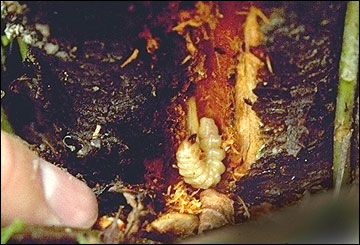 Figure 2
Figure 2
Roundheaded appletree borer larva at base of apple tree.
Hosts
The roundheaded appletree borer occurs throughout most of the United States and Canada. It attacks apple, pear, quince, mountain-ash, hawthorn and serviceberry.
Damage
The presence of pigtail-shaped frass and wood cuttings on the bark or at the base of the tree (Figure 2) and darkened areas in the bark (due to sap flow) are evidence of attack. One or two borers may kill a young tree, and trees 5 to 10 years old may suddenly break off at the ground because of earlier borer infestations. This borer does not seem to distinguish between weak and healthy trees.
Biology
The adult beetle is about 0.5 to 1 inch long with the antennae being about the same length. The body is entirely white except for three broad longitudinal brown stripes extending the full length of the body.
The borer has a two-year life cycle. Adult beetles usually appear in May and June, with egg-laying continuing until late July. Eggs typically are inserted into the bark of the trunk near the ground, although eggs may occasionally be laid in tree crotches.
The hatched larva begins feeding within the bark and by September, the larvae are found between the bark and sapwood. During this time the larvae eject wood cuttings and a rusty-brown frass from their tunnels. By the time winter sets in, the larvae have produced a tunnel about 3 to 4 inches long.
The larva passes the winter in the sapwood. During the following spring, summer and fall, the larva bores deeper — 1 to 2 inches — into the wood. A mature larva is about 1.25 inches long, fleshy, thin-skinned, white or yellowish, cylindrically shaped, with a brown head and a rounded thickening of the body just behind the head.
By fall of the second year, the larva excavates an overwintering and pupal chamber about 0.5 inch beneath the bark. In the spring, the larva pupates and passes into the adult stage. The adult escapes from the chamber by cutting away the bark cap. Adults will crawl over the surface of the tree and feed to some extent on the foliage and on the new twig growth. Despite having well-developed wings, the adult beetle usually will fly only short distances.
Control
Regular insecticide treatments applied to control other orchard pests aid somewhat in controlling the roundheaded appletree borer. The adults frequently will get enough poison to kill them when feeding on the new bark or leaves. As such, borer infestations usually are worse in neglected or abandoned orchards. The use of trunk wraps has not been entirely successful.
During August and September, growers should check each tree for the presence of the young larvae, especially in those parts of the orchard where previous infestations have occurred. In nearly all cases the newly hatched larvae will cause some sap flow at the point where they begin to feed. This brown sap stain usually can be seen easily on the surface of the bark.
When sap stains are found, a shallow slice in the surface of the bark with a sharp knife will expose or kill the young borer without causing any injury to the tree. At this time it is often possible to locate and destroy, with a flexible wire probed into the tunnel, an occasional second-year borer that may have escaped the previous year’s worming. It is best to worm the trees each year.
For chemical control, licensed pesticide applicators may apply chlorpyrifos, lambda-cyhalothrin or any other appropriately labeled product as a trunk and lower limb spray. Insecticides available for homeowner use include some formulations of carbaryl, permethrin and imidacloprid. Because adult emergence and egg-laying can occur over a relatively long period, two to three insecticide applications may be needed during June and July. Please read the label carefully for proper rates and application procedures before using any insecticide.
Shothole borer
Scolytus rugulosus (Muller) — Coleoptera: Scolytidae
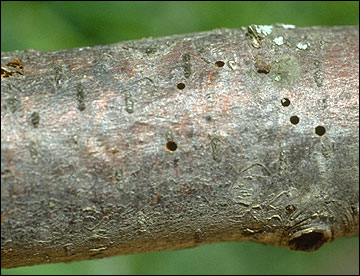 Figure 3
Figure 3
Emergence/exit holes of adult shothole borers.
Hosts
This bark beetle is a native of Europe, but now occurs throughout temperate North America. It attacks apple, peach, plum, cherry, quince, serviceberry and, occasionally, mountain-ash, hawthorn and elm.
Damage
The bark of infested twigs, branches and trunks is perforated with many small round holes. In stone fruits, gum often will appear in and around these holes (Figure 3). Shothole borer damage usually is limited to weak, declining trees, and infestations frequently hasten tree or limb death
Biology
The adult beetle is dark brown to black, blunt on both ends, and about 0.1 inch long. The tips of the antennae and legs are reddish brown. The wing covers are striated with rows of shallow punctures.
A larva, the overwintering stage, will feed on sapwood for about a month. The mature larva pupates within its tunnel and as an adult will chew a round hole through the bark and emerge. The small holes found in the bark can be either entrance or exit holes. After emerging, adult beetles can reinfest the tree or seek new host trees. Adults can fly long distances. There are usually two or more generations each year.
Adults emerge in April and May. The female beetle will bore through the bark and, at the wood-bark interface, begin excavating a gallery, or tunnel, that is about 2 inches long and runs parallel with the grain. Along the gallery, the female will lay several eggs. The hatching larvae will form their own galleries, which usually run across the grain and radiate out from the parental gallery. A larva is about 1/8 inch long, legless and white with a brown-red head, and has a slight enlargement of the body just behind the head. Larval galleries are generally packed with frass and sawdust, whereas parent galleries are usually clean.
Control
Keep all trees growing vigorously. Healthy trees exude resin, which usually kills shothole borers before much damage can be done. If the tree is weakened, this resin buildup, or gumming process, does not develop.
In addition, promptly prune and burn dead or badly infested trees or weak and dead limbs. Piles of pruned limbs and branches left in or near the orchard may serve as a breeding place for the beetle. Infested wood should be destroyed before adults emerge each April. Wild fruit trees and other potential breeding sites should also be removed.
Painting tree trunks with whitewash or white water-based latex paint may help repel the adult beetles, especially on young trees. Insecticide sprays are usually not very effective.
Peachtree borer
Synanthedon exitiosa (Say) — Lepidoptera: Sesiidae
Hosts
The peachtree borer occurs throughout most of the United States and Canada. This native clearwing moth primarily attacks peach, but it can survive on wild and cultivated cherry, plum, apricot and nectarine.
Damage
One of the first signs of peachtree borer attack is a mass of gum containing bits of wood chips, sawdust and frass (produced by the feeding larvae) exuding at the trunk base, about 3 inches below to 1 foot above the soil surface. Young trees may be completely girdled by the larval feeding. Older trees usually are not completely girdled, but a severe infestation can reduce an older tree’s vigor, making it susceptible to other insects and diseases.
Biology
The adult is a clear-winged, day-flying moth that resembles a wasp. The female moth is about 0.75 inch long with a 1.4-inch wingspan. She is dark blue with a broad orange band around the fourth and fifth abdominal segments. The forewings are opaque, and the hind wings are clear except for the margins.
In the male, both sets of wings are clear. The male is smaller, 0.5 inch long with a 1-inch wing span, and has a lighter steel-blue color than the female. The third and sixth abdominal segments are fringed with light-colored scales, and the tip of the slender abdomen is wedge shaped.
The adult moths begin to emerge in early June, peaking usually in late July or August and declining in September. Because adult moth emergence and egg laying can occur over a three- to four-month period, it is not unusual for an infested tree to have borers of varying sizes feeding beneath the bark.
Female moths can lay 400 to 500 eggs. Eggs are laid on tree trunks, in cracks or under bark scales, and in the soil near the tree trunk. Newly hatched larvae will bore through the bark to feed on the cambium tissue. Most larval activity is confined to the trunk area, a few inches above and below the ground line.
The mature larva is about 1.5 inches long and white except for a brown head. The larva overwinters in its tunnel. In the spring it resumes feeding, later leaving its tunnel and entering the soil to produce a cocoon of silk covered with wood particles, dirt and frass. The cocoon usually is in an upright position just beneath the soil surface around the trunk. The adult moth emerges from this cocoon. There is one generation per year.
Control. If the number of infested trees is small, some control can be obtained by digging out the larvae with a knife, a practice called hand-worming. However, this is a slow method and can injure the trees if every borer is located and removed. Hand-worming is not practical on a commercial basis.
For large commercial acreages, well-timed insecticide sprays of chlorpyrifos, esfenvalerate, lambda-cyhalothrin, endosulfan or any other appropriately labeled product, applied in August, will provide the most effective control. These trunk sprays should be directed from the lower scaffold branches down to the soil line. Soak the bark to runoff, so that a puddle of solution can be seen at the base of the tree. Please read the label carefully for proper rates and application procedures before using any chemical.
Lesser peachtree borer
Synanthedon pictipes (Grote and Robinson) — Lepidoptera: Sesiidae
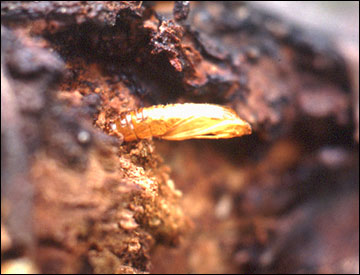 Figure 4
Figure 4
Pupal skin of lesser peachtree borer proturding from tunnel hole. Adults usually emerge in late April to early May.
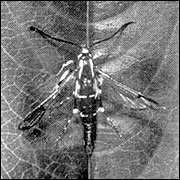
Hosts
The lesser peachtree borer is known to infest peaches, cherries and plums in eastern North America. Unlike its close relative, the peachtree borer, larvae of the lesser peachtree borer can be found throughout the tree.
Damage
The presence of wood chips, sawdust, and frass (produced by the feeding larvae) in the gum exuding from cankered or damaged areas on the trunk and larger branches are signs of infestation. Lesser peachtree borer infestations are almost always associated with areas on the tree damaged by disease, pruning wounds, mechanical damage and winter injury.
Biology
Both sexes of the lesser peachtree borer resemble the male peachtree borer. Veins and margins of the transparent wings are fringed with steel-blue scales. The body of the male and female is dark blue with pale yellow markings bordering the second and fourth abdominal segments. They are about 0.5 inch long and have a wing span of about 0.75 to 1.25 inches.
Adult moth emergence begins in late April to early May with a second adult flight occurring later in the summer, from late July through September. Adults are active for several weeks, and the female moth is capable of laying several hundred eggs.
Moths are attracted to trees that have been injured or previously infested. Eggs are laid in cracks or wounds in the bark, especially in tree crotches. The larvae feed on the cambium layer around the margins of the injured area and can enlarge the wounded area until the branch is girdled. Larvae of the lesser peachtree borer look very similar to larvae of the peachtree borer: a brown-headed worm that is white and about an inch long.
Larvae of various stages overwinter in their tunnels under the bark. In the spring, the larvae feed until mature and then form a silken cocoon near the bark surface. After adult emergence, a pupal skin often can be found protruding from the tunnel hole (Figure 4).
Control. Keeping trees strong, vigorous and free of injury will help prevent borer damage. Careful hand-worming or sealing tree wounds, preferably soon after they are made, with a tree paint can be helpful in controlling light infestations.
For large acreages, well-timed insecticide sprays during the season will provide the most effective control. Growers should place sex pheromone traps in the trees by petal fall, and keep a weekly record of the adult flight periods. If there is an average of two or more borers per tree, apply the an insecticide spray of chlorpyrifos, esfenvalerate, lambda-cyhalothrin, permethrin or any other appropriately labeled product at peak flight, which is typically late May to early June in central Missouri, and again in late summer (August). Insecticides available for homeowner use include some formulations of carbaryl and permethrin.
High-volume handgun sprays that thoroughly wet the trunk and scaffold limbs are necessary. Please read the label carefully for proper rates and application procedures before using any chemical.
Dogwood borer
Synanthedon scitula (Harris) — Lepidoptera: Sesiidae
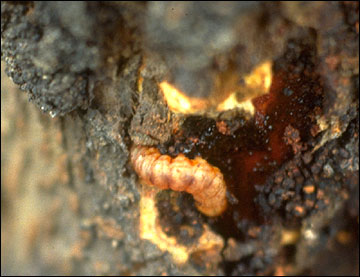 Figure 5
Figure 5
Larva of dogwood borer.
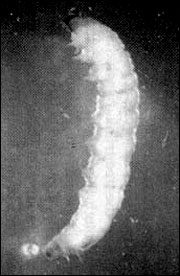 Hosts
Hosts
The dogwood borer occurs throughout the midwestern and eastern United States and southeastern Canada. Its numerous hosts include dogwood, oak, mountain ash, chestnut, willow, hickory, birch, pecan, apple, Prunus spp., hazel, myrtle and others.
Damage
In apple orchards, the dogwood borer is frequently found infesting the burrknots or adventitious (aerial) roots that grow just below the exposed graft union on dwarf and semidwarf trees. Severe dogwood borer infestations can girdle and kill a tree. Persistent infestations over several years can contribute to a slow decline in a tree’s vigor and reduced yields.
Biology
The adult moth is about 0.5 inch long with a wingspan of 0.75 inch. Both pairs of wings are clear except for the veins and margins, which are fringed with steel-blue scales. The body is blue-black except for yellow bands on the second and fourth abdominal segments, similar to the adult lesser peachtree borer. The legs are mostly yellow.
Adult moth emergence generally begins in early June and can continue into September. Eggs usually are laid on rough bark or around wounds. After hatching, the larvae begin to burrow into the tissue.
A mature larva is about 0.6 inch long, white to cream colored with a pale brown head (Figure 5). As the larvae feed, reddish brown frass is pushed to the surface of the tunnel, where it collects and is held together by silk. A feeding tunnel may be as much as 0.75 inch deep.
As the burrknot tissue is consumed, the larvae will move outward and begin to feed on the cambium of healthy bark. Overwintering is done in the larval stage in the feeding tunnel. In the spring, the larva resumes feeding. Before pupation, the larva will construct a tough silken cocoon covered with bits of frass. After adult emergence, the empty pupal case often remains protruding from the surface of the burrknot. There is usually one generation per year.
Control
Preventing burrknot development on clonal rootstocks can go a long way in managing dogwood borer infestations in apple. When planting new trees, cover the rootstock to the point just below the graft union. This process will help arrest burrknot development.
In established plantings, if the graft union is not too high above the ground, place soil around the trunk in a wide cone up to the graft union, covering the burrknots. The cone of soil must be wide enough to prevent freezing injury to the buried rootstock. The mounding of soil around such rootstocks will not only prevent adult dogwood borer moths from laying eggs at the burrknots, but will also result in root development from the burrknot sites.
If the graft union is so high above the ground that it is impossible to bury the rootstock, white latex paint brushed on the exposed portion of the rootstock before egg laying begins can help prevent new infestations. For large acreages, where such cultural techniques are not practical, well-timed insecticide sprays during the season will provide the most effective control.
Growers should use sex pheromone traps and keep a weekly record of the adult moth flight periods. The first insecticide spray should be applied at peak flight, which runs from mid to late June through early July. Because the adult moths emerge over a long period, a second insecticide application may be warranted in August. All chemical applications should consist of high-volume handgun sprays that thoroughly wet the trunk below the graft union and are applied to the point of runoff. Licensed applicators may use chlorpyrifos, lambda-cyhalothrin or any other appropriately labeled product. Insecticides available for homeowner use include some formulations of carbaryl and permethrin. Please read the label carefully for proper rates and application procedures before using any chemical.